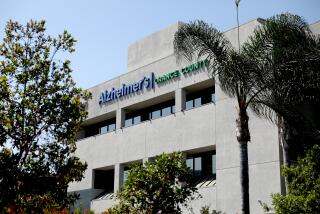Hope’s on the horizon for macular disease
- Share via
The loss of vision begins gradually, in the middle of the retina, so that only objects on the periphery are visible.
Over time, this blind spot grows bigger, eroding the ability to read, drive and watch television. Eventually, sufferers can no longer make out sharp contrasts or vivid lines -- nor can they distinguish faces.
Known as the wet form of macular degeneration, the condition is caused by the abnormal growth of blood vessels beneath the macula, or central portion of the retina. These vessels leak fluid and blood, causing scarring that damages the photoreceptors within the retina.
Though not a cure, two experimental drugs may halt or even reverse the vision loss. Both are in the final stages of testing, and one of them may be on the market within the next year.
“If they prove effective, it would really be a wonderful breakthrough,” says Dr. Christine R. Gonzales, an ophthalmologist with the Jules Stein Eye Institute at UCLA’s Geffen School of Medicine. “Right now, we don’t have anything for most patients.”
Age-related macular degeneration is the leading cause of blindness in adults over the age of 55. The “dry” form, which is more common and affects about 85% to 90% of sufferers, is caused by the progressive weakening of the macular tissue; the resulting vision loss is gradual. In the more serious, wet form of the disease, vision loss occurs quickly and is more debilitating.
More than 200,000 new cases of the wet form are diagnosed each year, and as baby boomers age, incidence rates are expected to triple by 2025. Currently, more than 1.5 million Americans have the condition.
Scientists now know that a natural protein, vascular endothelial growth factor, or VEGF, stimulates the proliferation of the blood vessels beneath the macula. Both drugs work by inhibiting the production of VEGF.
Genentech’s Lucentis is composed of a genetically engineered antibody fragment. The particle is programmed to latch onto VEGF cells, which throws a monkey wrench into the cells’ reproductive machinery. Similarly, Macugen, which is made by EyeTech Pharmaceuticals in New York, is a chemically synthesized strand of genetic material that binds to the cell’s surface, which prevents it from replicating.
“These drugs are exciting because they attack the root of the problem rather than just the aftermath of aging or scarring,” says Dr. Michael F. Marmor, an ophthalmology professor at the Stanford University School of Medicine in Palo Alto. “Still, they’re not a cure. Once you start getting vision loss, scar tissue has formed and there’s some damage to the retina, so nothing will completely restore lost vision.”
Early tests of both drugs were promising. In a 2002 study, Macugen was injected directly into the eyes of 21 patients. Three months after treatment, 87.5% of the volunteers had stable vision, while 25% experienced a three-line or greater improvement in their ability to read the lines on an eye chart.
Similarly, of 40 patients treated with Lucentis for six months, 97.5% of patients had stable or improved vision, and 45% were able to read an additional 15 letters or more on the eye chart. A control group that didn’t get the drug lost an average of 5.1 letters in three months.
“The data is quite remarkable,” says Dr. Kent W. Small, an ophthalmologist and retinal surgeon at UCLA’s Geffen School of Medicine who has tested both drugs.
Lucentis is now in the midst of the final phase of testing on about 1,200 patients. A large trial of Macugen, which encompassed 1,196 patients at 117 research centers around the world, was recently completed and the results will be released later this month.
*
(BEGIN TEXT OF INFOBOX)
Current treatments
Until recently, the most widely used treatment for the wet form of macular degeneration was photocoagulation therapy, which used a heating laser to seal blood vessels. Only 10% of patients were good candidates for this procedure, which could also cause blind spots.
Photodynamic therapy, also called PDT, was approved in 2000. It was an advance over the earlier treatment because it slowed the progression of vision loss without the risk of causing further damage. During PDT, a patient is injected with the photosensitive drug, Visudyne (verteporfin), which collects in the abnormal blood vessels. A laser is used to activate the drug, which seals the leaking vessels.
However, the therapy is temporary because the blood vessels reopen after several months, which means patients require several more costly treatments. And PDT works for only 10% to 20% of sufferers, says Dr. Christine R. Gonzales, a Jules Stein Eye Institute ophthalmologist, “leaving us with a large group of patients for which we don’t have any treatments.”





